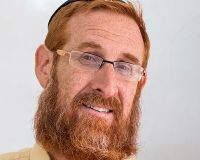Yehuda Glick permitted back on Temple Mount – kind of
by - 13th May 2015
 LAST week saw a major ruling by the Jerusalem magistrate’s court over activist Yehudah Glick's campaign for the right of Jews to pray on Jerusalem’s Temple Mount.
LAST week saw a major ruling by the Jerusalem magistrate’s court over activist Yehudah Glick's campaign for the right of Jews to pray on Jerusalem’s Temple Mount.
Glick, an American-born Israeli rabbi, is chairman of the Temple Mount Heritage Foundation, an organization that promotes the right of Jews, Christians and Muslims to pray on Temple Mount.
The ruling now permits him to visit the Mount once a month, subject to conditions.
After the 1967 Six-Day War, the Israelis left control of the Mount to the Waqf, a charitable endowment overseen by the Jordanians.
Since then, Jews and Christians have been unable to pray on the Mount, to avoid exacerbating tensions.
Glick’s lawyer, Aviad Visoly, is reported to have commented: ‘Essentially, the court took the ruling of the Supreme Court regarding the right of Jews to pray at the Temple Mount, and implemented it in practice.
‘But doubts remain on whether this ruling would actually lead to Jewish prayer being allowed at the site in practice, with Israeli Prime Minister Benjamin Netanyahu reiterating last year his commitment to maintaining the status-quo on the Temple Mount issue.’
Over the years, Rabbi Glick has drawn fire over his work.
In October 2014, he was shot four times after giving a speech at the Menachem Begin Heritage Center in Jerusalem, in which he had called for freedom of worship on the Mount.
Glick later reported that before shooting him, the gunman had told him, ‘I’m very sorry, but you’re an enemy of Al-Aqsa, I have to.’
Al-Aqsa is the large mosque on Temple Mount, which also houses the Dome of the Rock, and the term Al-Aqsa is often used to speak of the entire Mount compound.
After the shooting, the Temple Mount was briefly closed even to Muslims.
US Secretary of State John Kerry joined those calling for a return to the status quo ante:
‘The Haram al-Sharif/Temple Mount must be re-opened to Muslim worshippers and I support the long-standing practices regarding non-Muslim visitors to the site, consistent with respect for the status quo arrangements governing religious observance there.’

In November 2014, Rabbi Glick admitted on television that he prays regularly when he visits the holy site.
Even a non-Muslim moving his or her lips in apparent prayer on the Mount is forbidden by the Waqf.
Glick told his interviewer, ‘Every time I go up to the Temple Mount, I pray. Today, too, I prayed the afternoon prayer on the Temple Mount. I go up to pray, but I don’t want to do it like a thief in the night.
‘I do it all sorts of ways — as a guide, I stand as a guide because I’m a certified [national tour] guide, that’s my profession. Or I do it as a phone call.’
Glick claimed: ‘The police know this, the courts know this, and the Waqf knows this too, and they laugh with me about this. I want to do it like a normal person.’
Rabbi Glick has also been videotaped reciting Muslim sacred texts with Muslims on the Mount, then reciting a Jewish text and teaching it to one of the Muslims present.
The Jerusalem Post reported: ‘Despite police opposition alleging that Glick, a spokesman for the right-wing Joint Committee of Temple Organizations, presents a danger to public order at the compound, Judge Miriam Kaslassy said he could visit once a month and was not allowed to carry a cellphone or call out in a provocative manner.’
Ha’aretz has reported that pressure for Jews to be allowed to pray on the Mount has recently ‘gone mainstream’, while noting the conflicting views on Glick’s actions.
It quoted one Anshel Pfeffer: ‘Yehuda Glick is a dangerous extremist whose actions could plunge us all into a bloody religious war. Yehuda Glick is a civil rights activist bravely fighting for freedom of worship. Yehuda Glick is a Jewish supremacist seeking to extend Israeli occupation to one of Islam’s most sacred sites. Yehuda Glick is a sweet-natured, gentle man seeking to fulfil the vision of our prophets where members of all faiths come to Jerusalem to pray side-by-side in peace.’
Peace, in today’s Jerusalem, is, it seems, as elusive as ever.
ANALYSIS: What are the political implications of the lifting of the Temple Mount prayer restriction?
CORRECTION:
This article has been corrected to clarify that the Dome of the Rock is a shrine, not a mosque.
